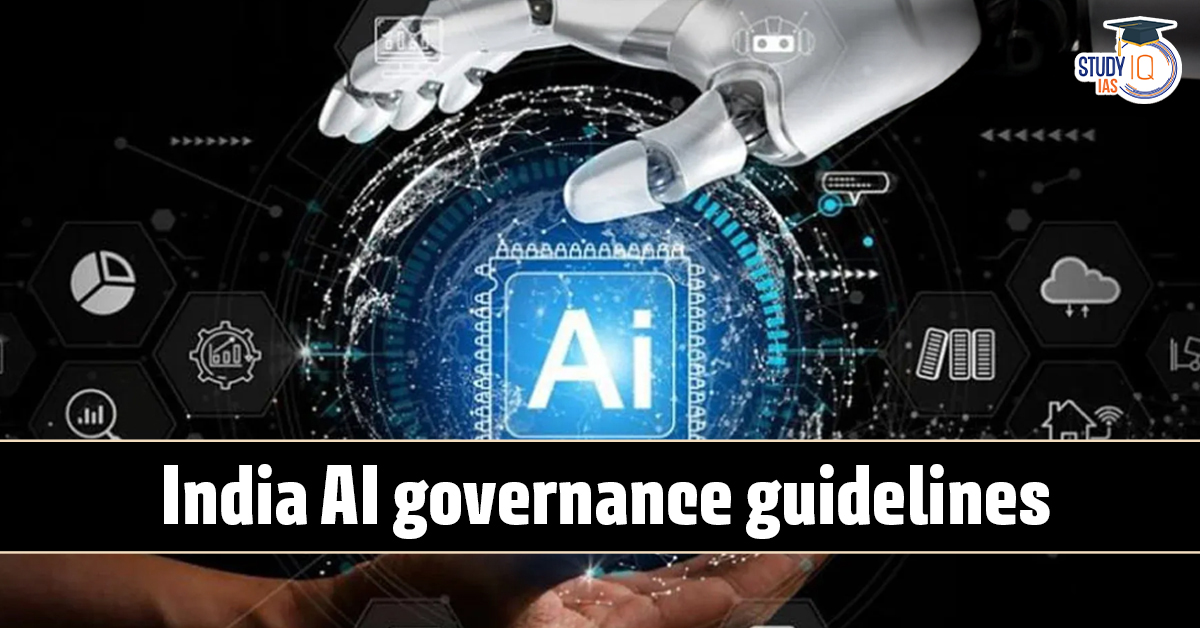Table of Contents
India has entered the age of Artificial Intelligence (AI) — a transformative technology that promises to redefine productivity, innovation, and inclusion. Recognising both the enormous potential and emerging risks of AI, the Government of India has released the India AI Governance Guidelines (2025) under the IndiaAI Mission.
The guidelines aim to ensure that AI remains safe, trustworthy, inclusive, and innovation-driven, supporting the vision of Viksit Bharat 2047.
What Are the India AI Governance Guidelines?
The India AI Governance Guidelines provide a national framework for governing artificial intelligence systems through a techno-legal, inclusive, and principle-based approach.
The framework seeks to balance innovation with accountability — ensuring that India harnesses AI’s power for growth, inclusion, and sustainability while safeguarding citizens from potential harm such as deepfakes, algorithmic bias, and data misuse.
The document is structured into four major parts:
-
Key Principles (Seven Sutras)
-
Issues & Recommendations (Six Pillars)
-
Action Plan (Short, Medium & Long-Term)
-
Practical Guidelines for Industry & Regulators
Vision: AI for All
The guidelines align with Prime Minister Narendra Modi’s vision of “AI for All”, focusing on:
-
Inclusion and accessibility across all sections of society.
-
Leveraging AI for rural health, education, climate resilience, and agriculture.
-
Making AI a trustworthy enabler of digital empowerment.
Seven Sutras of AI Governance
These seven guiding principles, inspired by the RBI’s FREE-AI framework, form the ethical foundation of India’s AI governance model:
| Sutra | Meaning |
|---|---|
| 1. Trust is the Foundation | Public trust is essential for innovation, adoption, and progress. |
| 2. People First | Human oversight, empowerment, and centricity in AI design. |
| 3. Innovation over Restraint | Encourage responsible innovation while mitigating harm. |
| 4. Fairness & Equity | Prevent bias and promote inclusion for marginalised groups. |
| 5. Accountability | Assign responsibility based on risk, role, and diligence. |
| 6. Understandable by Design | Ensure transparency and explainability in AI systems. |
| 7. Safety, Resilience & Sustainability | Build safe, robust, and environmentally responsible AI systems. |
Six Pillars of AI Governance
The India AI Governance Guidelines are implemented through six interlinked pillars spanning enablement, regulation, and oversight.
Infrastructure
-
Expand access to data, compute, and AI models through platforms like AIKosh.
-
Leverage Digital Public Infrastructure (DPI) — such as Aadhaar, UPI, and DigiLocker — to make AI scalable and inclusive.
-
Provide GPU access, tax incentives, and AI-linked loans for startups and MSMEs.
Capacity Building
-
Strengthen AI education, skilling, and training.
-
Train civil servants, regulators, and law enforcement agencies on AI risks and governance.
-
Launch awareness campaigns to build public trust in AI technologies.
Policy & Regulation
-
Apply existing laws (IT Act, DPDP Act, Copyright Act, Consumer Protection Act) to AI-related harms.
-
Identify regulatory gaps and amend laws where needed — such as copyright for AI training and classification of AI systems.
-
Establish regulatory sandboxes for safe experimentation.
Risk Mitigation
-
Develop an India-specific AI Risk Framework to classify harms.
-
Address deepfakes, bias, and systemic risks through techno-legal solutions.
-
Create a National AI Incident Database to track real-world AI harms.
Accountability
-
Implement a graded liability system based on function and risk.
-
Encourage voluntary frameworks, transparency reports, and self-certifications.
-
Mandate grievance redressal systems for citizens affected by AI-related harms.
Institutions
Establish three key institutional pillars:
-
AI Governance Group (AIGG): High-level policy body coordinating AI governance.
-
Technology & Policy Expert Committee (TPEC): Provides technical and legal expertise.
-
AI Safety Institute (AISI): Conducts safety testing, research, and standard-setting.
Action Plan: Roadmap to Safe AI
| Timeframe | Key Actions | Outcomes |
|---|---|---|
| Short-term (1–2 years) | Set up AIGG & TPEC; Develop risk framework; Launch awareness drives | Strong institutional base |
| Medium-term (2–4 years) | Publish standards; Operationalise AI Incident Database; Amend laws | Mature regulatory framework |
| Long-term (5+ years) | Draft new AI laws; Expand global diplomacy; Continuous risk review | Future-ready, agile governance |
Techno-Legal Approach
India’s framework uniquely combines technology with law — embedding compliance mechanisms within digital systems.
Examples include:
-
DEPA for AI Training: Consent-based data sharing for AI development.
-
Watermarking and content provenance tools for deepfake detection.
-
Privacy-preserving architectures using Digital Public Infrastructure (DPI).
This approach ensures “compliance by design” and promotes scalable, responsible innovation.
Voluntary and Industry-Led Measures
The guidelines encourage voluntary commitments from industry, such as:
-
Publishing AI transparency reports.
-
Adopting bias detection and privacy tools.
-
Setting up grievance redressal mechanisms.
-
Developing open standards and algorithmic audits.
Such self-regulation complements government oversight and promotes a trust-based AI ecosystem.
Global Diplomacy and India’s Leadership
India’s AI governance model is designed to be replicable for the Global South.
The government will advance AI diplomacy through:
-
Participation in G20, UN, OECD, and the AI Safety Network.
-
Hosting the AI Impact Summit 2026.
-
Promoting global standards for content authentication and AI ethics.
Key Recommendations
- Develop an AI-specific risk classification framework
- Integrate AI with Digital Public Infrastructure
- Expand access to GPU & AI data resources
- Establish AI Incidents Database and Grievance Mechanisms
- Encourage voluntary compliance and techno-legal safeguards
- Build AI capacity across regulators and institutions
- Ensure India’s global leadership in ethical AI diplomacy
Impact and Relevance
The India AI Governance Guidelines (2025) position India as a global pioneer in responsible AI policy — combining innovation, inclusion, and accountability.
By focusing on trust, transparency, and human empowerment, these guidelines aim to transform AI from a disruptive force into a tool for equitable national progress.


 National Maritime Heritage Complex (NMHC...
National Maritime Heritage Complex (NMHC...
 Reforming Fertiliser Subsidy in India: N...
Reforming Fertiliser Subsidy in India: N...
 Micrometeoroids: Tiny Space Particles, M...
Micrometeoroids: Tiny Space Particles, M...

























